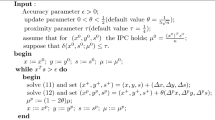Abstract
A predictor—corrector method for solving linear programs from infeasible starting points is analyzed. The method is quadratically convergent and can be combined with Ye's finite termination scheme under very general assumptions. If the starting points are large enough then the algorithm hasO(nL) iteration complexity. If the ratio between feasibility and optimality at the starting points is small enough then the algorithm has O(\(\sqrt {n L} \)) iteration complexity. For feasible starting points the algorithm reduces to the Mizuno—Todd—Ye predictor—corrector method.
Similar content being viewed by others
References
K.M. Anstreicher, J. Ji, F.A. Potra and Y. Ye, “Probabilistic analysis of an infeasible primal—dual algorithm for linear programming,” Reports on Computational Mathematics No. 27, Dept. of Mathematics, University of Iowa (Iowa City, IA, 1992).
R.M. Freund, “Following a “balanced” trajectory from an infeasible point to an optimal linear programming solution with a polynomial-time algorithm,” Working Paper No. 3452-92-MSA, Massachusetts Institute of Technology (Cambridge, Massachusetts 02139, 1992).
J. Ji and F. Potra, “On the average complexity of finding an∈-optimal solution for linear programming,” Reports on Computational Mathematics No. 25, Dept. of Mathematics, University of Iowa (Iowa City, IA, 1992).
N. Karmarkar, “A new polynomial-time algorithm for linear programming,”Combinatorica 4 (1984) 373–395.
M. Kojima, N. Megiddo and S. Mizuno, “A primal—dual infeasible-interior-point algorithm for linear programming,”Mathematical Programming 61 (1993) 263–280.
I.J. Lustig, R.E. Marsten and D.F. Shanno, “Computational experience with a primal—dual interior point method for linear programming,”Linear Algebra and its Applications 152 (1991) 191–222.
I.J. Lustig, R.E. Marsten and D.F. Shanno, “Computational experience with a globally convergent primal—dual predictor—corrector algorithm for linear programming,” Technical Report, Dept. Civil Eng. and O.R., Princeton University (Princeton, NJ, 1992).
S. Mehrotra, “Quadratic convergence in primal—dual method,” Technical Report TR 91-15, Department of IE and MS, Northwestern University (Evanston, IL, 1991).
S. Mehrotra and Y. Ye, “On finding the optimal facet of linear programming,” Technical Report, Department of IE and MS, Northwestern University (Evanston, IL, 1991).
S. Mizuno, “Polynomiality of Kojima—Megiddo—Mizuno infeasible interior-point algorithm for linear programming,” Technical Report, School of OR and IE, Cornell University (Ithaca, NY, 1992).
S. Mizuno, M.J. Todd and Y. Ye, “On adaptive-step primal—dual interior-point algorithms for linear programming,”Mathematics of Operations Research 18 (1993) 964–981.
R.C. Monteiro and I. Adler, “Interior path-following primal—dual algorithms. Part I: linear programming,”Mathematical Programming 44 (1989) 27–41.
A.M. Ostrowski,Solution of Equations in Euclidian and Banach Spaces (Academic Press, New York, 1973).
F.A. Potra, “An infeasible interior-point predictor-corrector algorithm for linear programming,” Reports on Computational Mathematics No. 26, Dept. of Mathematics, University of Iowa (Iowa City, IA, 1992).
F.A. Potra, “A quadratically convergent infeasible interior-point algorithm for linear programming,” Reports on Computational Mathematics, No. 28, Dept. of Mathematics, University of Iowa (Iowa City, IA, 1992).
F.A. Potra, “On a predictor-corrector method for solving linear programs from infeasible starting points,” Reports on Computational Mathematics No 34, Dept. of Mathematics, University of Iowa (Iowa City, IA, 1992).
Y. Ye, “On the finite convergence of interior-point algorithms for linear programming,” Working paper 91-5, Dept. of Management Sciences, University of Iowa (Iowa City, IA, 1991).
Y. Ye, O. Güler, R. Tapia and Y. Zhang, “A quadratically convergent O(\(\sqrt n L\))-iteration algorithm for linear programming,”Mathematical Programming 59 (1993) 151–162.
Y. Zhang, “On the convergence of an infeasible interior-point algorithm for linear programming and other problems,” Technical Report, Department of Mathematics and Statistics, University of Maryland (Baltimore, MD, 1992).
Author information
Authors and Affiliations
Additional information
This work was supported by an interdisciplinary research grant from the Institute for Advanced Studies of the University of Iowa.
Rights and permissions
About this article
Cite this article
Potra, F.A. A quadratically convergent predictor—corrector method for solving linear programs from infeasible starting points. Mathematical Programming 67, 383–406 (1994). https://doi.org/10.1007/BF01582228
Received:
Revised:
Issue Date:
DOI: https://doi.org/10.1007/BF01582228




